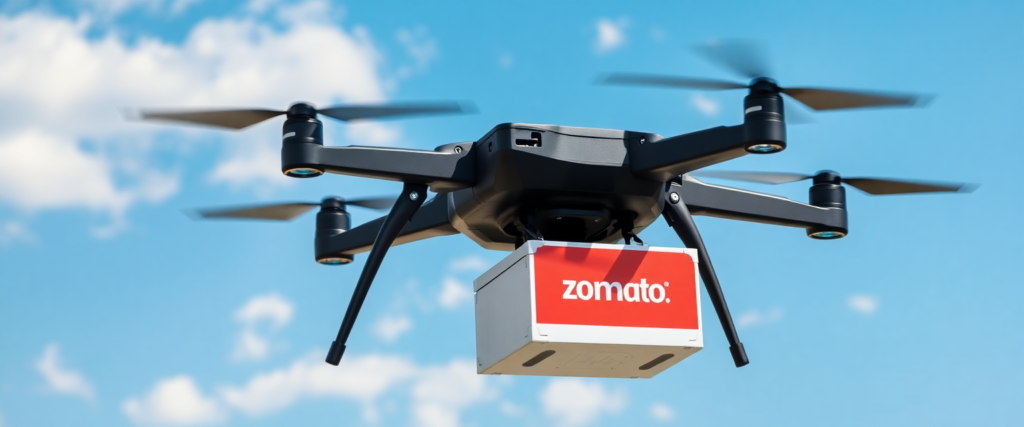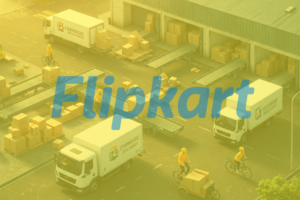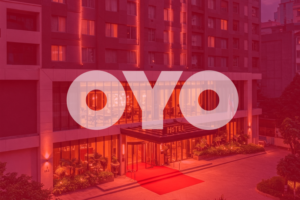1. Introduction to Zomato
Zomato is an indian multinational food-tech company that was founded in 2008 as FoodieBay by Deepinder Goyal and Pankaj Chaddah, who previously worked for Bain & Company. FoodieBay website was started as a restaurant-listing-and-recommendation portal. Later, in 2010, it was renamed to Zomato. In its journey of over 15 years, Zomato has become a major player in the Indian food-tech industry. Today, Zomato connects diverse cultures through its 5000+ team members, 3.5 lakh+ delivery partners, and its biggest group of the finest restaurant partners.
2. Zomato’s Core Services
Having started as a restaurant-listing-and-recommendation portal, Zomato has diversified its services. It has started some services on its own and some by acquiring other businesses and then rebranding them. Here are some of Zomato’s popular services, both of which are going on and discontinued today.
1. Find, Review & Book Restaurants: The Zomato platform enables users to discover restaurants, read and write customer-generated reviews, view and upload photos, and book a table reservation at restaurants.
2. Online Food Delivery: Zomato enables users to order food from a vast network of partner restaurants across India.

3. Zomato Infrastructure Services: In February 2017, it announced plans to launch Zomato Infrastructure Services, a cloud kitchen infrastructure service for its partners. This allowed restaurants to expand into new locations without investing in property, staff, and equipment, meaning they could focus on food preparation and branding while Zomato managed kitchen infrastructure, logistics, and delivery. But in 2018, Zomato shut down operations of Zomato Infrastructure Services.
4. Hyperpure: In 2018, Zomato acquired WOTU and rebranded it as Hyperpure. It supplies food ingredients, such as grains, vegetables, and meat, to Zomato restaurant partners.
5. Zomaland: In December 2018, Zomato launched Zomaland, which is its annual multi-city food and entertainment carnival that features food, music, games, and other activities.
6. Zomato Market: In April 2020, due to the fall of the food delivery market and demand for online grocery ordering because of the COVID-19 pandemic, Zomato launched Zomato Market, which delivered groceries and essentials in more than 80 cities across India. But in June 2020, Zomato closed the operations of Zomato Market as demand for food delivery recovered and the grocery delivery business “was not scalable”.
7. Zomato Instant and Intercity Legends: Zomato Instant was a 10-minute food delivery service launched in Gurgaon in April 2022. Later that year, Zomato launched Intercity Legends in Delhi NCR, which allowed users to have food delivered from famous restaurants in other cities within a few days. But Zomato discontinued both services due to challenges in achieving profitability and product-market fit.
8. Blinkit: In June 2022, Zomato announced the acquisition of quick-commerce company Blinkit for US$568 million. This acquisition expanded Zomato’s services beyond food delivery to grocery and essentials delivery.
9. Xtreme: In October 2023, Zomato started a hyperlocal package delivery service on a separate app called Xtreme.
10. District: Zomato launched District in August 2024, which is an events and ticketing app, after acquiring Paytm‘s ticketing business.
3. Business Model and Revenue Streams
Zomato has diversified revenue streams. Some of its major revenue streams are listed below:
Food Delivery and Table Reservation Commissions
This is one of Zomato’s main revenue streams. When a user orders food from a restaurant via the Zomato app, Zomato charges a percentage of the order value as a commission from the restaurant. This commission varies but is typically in the range of 15% to 25% of the order amount, depending on the restaurant’s agreement with Zomato. Also, Zomato earns a commission from the restaurant for each successful reservation made through its platform.
Delivery Fees
Zomato also sometimes charges customers for delivery fees for food orders. The amount varies based on factors such as order value and location.
Advertising and Promotions
Zomato offers restaurants to promote themselves and increase their visibility on Zomato through paid advertising. This includes features such as banner placements, priority listings, targeted ad campaigns, and special deals to attract customers.
Subscription Programs
Zomato offers subscription services like Zomato Gold (now Zomato Pro), which gives members special benefits such as discounts and faster delivery. These memberships generate repeat revenue for Zomato.
Hyperpure
Zomato supplies fresh ingredients and kitchen essentials to restaurants. This B2B service under Zomato’s Hyperpure ensures not only high-quality supplies for eateries but also contributes to Zomato’s revenue.
Blinkit (Quick Commerce)
Zomato’s quick-commerce service, Blinkit, earns revenue through multiple streams. It charges local merchants a commission fee for sales made on its platform, while customers pay delivery fees for the convenience of fast service. Additionally, Blinkit offers subscription services that include benefits like free deliveries, and it generates income from advertising fees, where brands pay to promote their products on the app and website.
4. Technology and Innovation
Zomato has consistently led the way in using technology and innovation to transform the food delivery and dining experience. The company has integrated advanced AI and machine learning algorithms to personalize user experiences, optimize delivery routes, and predict food trends. For example, Zomato’s AI-driven recommendation engine analyzes user behavior and preferences to suggest restaurants and dishes, enhancing customer satisfaction.
Additionally, Zomato introduced Hyperpure, a farm-to-fork initiative that ensures partner restaurants receive high-quality ingredients, demonstrating the company’s commitment to innovation in supply chain management. Zomato has also embraced drone delivery trials in select regions, intending to reduce delivery times and carbon footprints, aligning with global sustainability objectives.

Furthermore, Zomato’s use of big data analytics helps restaurants understand customer preferences and optimize their menus, creating a mutually beneficial situation for both parties. By continually pushing the boundaries of technology, Zomato enhances operational efficiency and sets new standards for the food tech industry.
5. Market Presence and Expansion
Zomato, originally launched as a restaurant discovery platform in India, quickly expanded into major cities and later ventured into international markets, entering countries across Asia, Europe, and the Middle East. By acquiring platforms like Urbanspoon, it gained access to markets such as the United States and Australia, strengthening its global presence. Over time, however, the company streamlined its focus back to India and the UAE.
As Zomato evolved, it expanded beyond restaurant discovery into food delivery, launching its own services and acquiring companies to enhance logistics and order fulfillment. It introduced innovations like table reservations, point-of-sale systems, and real-time delivery tracking, improving both customer experience and restaurant operations. While it briefly experimented with cloud kitchens, grocery delivery, and alcohol distribution, Zomato ultimately focused on its core strength—food delivery.
This strategic focus paid off, as Zomato now dominates India’s food delivery market with a 58% share, outpacing Swiggy’s 34%. In the last year alone, the company reported an impressive ₹322.24 billion ($3.82 billion) in orders and projects, 30% annual growth over the next five years. The acquisition of Blinkit further expanded its reach into quick commerce, while features like Zomato Pay and hyperlocal package delivery showcase its efforts to diversify its offerings.
Going public in 2021 was a defining moment, cementing Zomato’s transition from a startup to a market leader. Today, it continues to drive innovation in food delivery, restaurant tech, and digital payments, reinforcing its dominance in India’s food-tech industry.
6. Impact on the Food Industry
Zomato has significantly transformed India’s food industry by integrating technology into the dining and delivery experiences. Initially launched as a restaurant discovery platform, Zomato expanded its services to include food delivery, table reservations, and point-of-sale systems, enhancing both customer convenience and restaurant operations.
Its innovations have reshaped consumer behavior, making food more accessible through digital platforms while boosting restaurant revenues. The company’s influence extends beyond food delivery, streamlining dining experiences and setting new industry standards for speed and service quality.
7. Challenges and Controversies
Zomato has encountered several challenges and controversies in recent years:
Antitrust Investigations: In March 2025, the Competition Commission of India (CCI) initiated an antitrust investigation into Zomato, Swiggy, and Zepto. The probe was prompted by complaints from consumer product distributors alleging that these platforms engaged in deep discounting and predatory pricing practices, adversely affecting traditional retailers. (source – Reuters)
Advertising Controversies: Zomato has faced backlash over certain advertising campaigns. Notably, an advertisement featuring a delivery executive serving Bollywood celebrities was criticized for allegedly downplaying the challenges faced by delivery personnel. Additionally, a series of billboard ads in Delhi-NCR used colloquial slang that many found offensive, leading to public outcry and the subsequent removal of the ads. (source – peppercontent.io)
‘Pure Veg’ Delivery Fleet: In 2024, Zomato introduced a ‘pure veg’ delivery service with delivery partners wearing green uniforms to signify handling only vegetarian orders. This move sparked debates around caste and food purity in India, with critics arguing that it reinforced societal divisions. (source – aljazeera.com)
Suspicious Restaurant Listings: The platform faced scrutiny over the presence of dubious ‘one-dish’ restaurants, leading to conspiracy theories and concerns about the authenticity of some listings. Zomato issued clarifications addressing these concerns to maintain trust among users. (source – ndtv.com)
Leadership Hiring Practices: In November 2024, CEO Deepinder Goyal announced a Chief of Staff position requiring applicants to pay a ₹20 lakh (approximately $23,700) fee instead of receiving a salary initially. This approach was criticized for potentially excluding talented individuals from less privileged backgrounds. (source – Reuters)
These incidents highlight the complex challenges Zomato faces in balancing innovation with ethical considerations and stakeholder expectations.
8. Mission and Social Responsibility
Mission Statement
Zomato’s mission is to provide “better food for more people,” reflecting its commitment to enhancing food experiences globally. (source – Zomato)
Corporate Social Responsibility (CSR) Initiatives
Zomato actively engages in various CSR initiatives aimed at environmental sustainability and community well-being:
Environmental Sustainability: As part of its commitment to environmental responsibility, Zomato became the first food delivery company worldwide to join the EV100 initiative by the Climate Group in 2021, aiming for 100% electric vehicle adoption for deliveries by 2030. (source – unreadwhy.com)
Plastic-Free Future Campaign: Zomato launched the ‘Plastic-Free Future’ campaign to recognize and promote restaurant partners adopting sustainable packaging solutions, aiming to reduce plastic waste in food delivery. (source – thecsruniverse.com)
Food Rescue Initiative: To address food wastage, Zomato introduced the ‘Food Rescue’ feature, allowing the redistribution of canceled orders to those in need, thereby enhancing business efficiency and contributing to social welfare. (source – LinkedIn)
Support for Restaurant Partners and Gig Workers: Zomato unveiled sustainability goals for 2030, which include supporting the growth of 300,000 restaurant businesses and food entrepreneurs, empowering 1 million gig workers, and facilitating 300 million nutritious meals for underprivileged women and children. (source – storyboard18.com)
Through these initiatives, Zomato demonstrates its dedication to not only enhancing food experiences but also promoting environmental sustainability and social responsibility.
9. Future Outlook
Zomato’s future looks promising, with plans to expand its reach, introduce new stores, and enhance its food delivery services. The company expects its business to grow by 30% annually over the next five years, driven by rising demand and increasing online food orders. Zomato is also leveraging technology to improve customer experience and help restaurants make better decisions. With the food delivery industry set to grow rapidly, Zomato aims to strengthen its position while exploring new opportunities in related sectors.
10. Conclusion
Zomato has grown from a restaurant-listing platform to a leader in India’s food-tech industry, offering diverse services like food delivery, quick commerce, and event ticketing. Despite challenges, it continues to innovate, expand, and uphold sustainability efforts. With a strong market presence and a focus on technology, Zomato is set to drive the future of food delivery and restaurant services.










